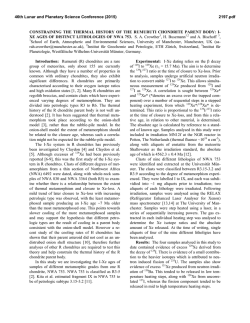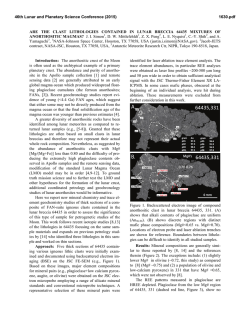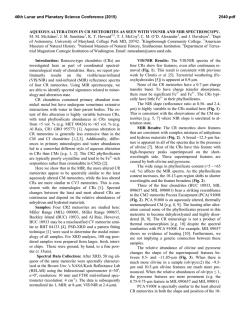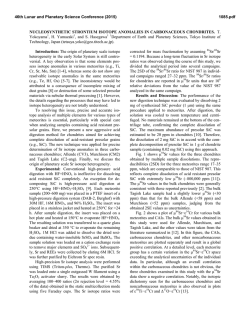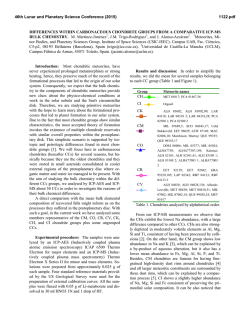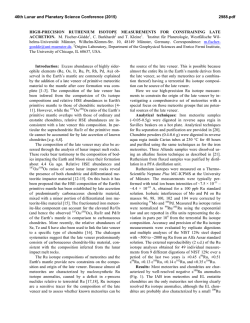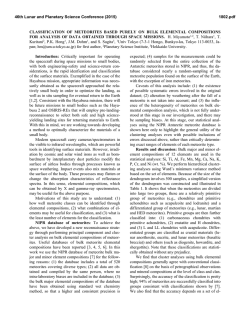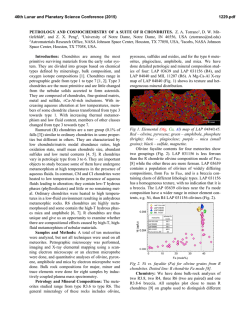
LITHOLOGIES MAKING UP CM CARBONACEOUS - USRA
46th Lunar and Planetary Science Conference (2015) 1227.pdf LITHOLOGIES MAKING UP CM CARBONACEOUS CHONDRITES AND THEIR LINK TO SPACE EXPOSURE AGES. Timothy Gregory1, Michael E. Zolensky2, Alan Trieman3, Eve Berger2, Loan Le2, Amy Fagan3, Atsushi Takenouchi4, Michael A. Velbel5, Kunihiko Nishiizumi6, 1The University of Manchester (School of Earth, Atmospheric and Environmental Science, University of Manchester, Manchester, M13 9PL, United Kingdom, [email protected]), 2NASA Johnson Space Centre, Houston, TX 77058, USA, 3Lunar and Planetary Institute, Houston, TX 77058, USA, 4University of Tokyo, Hongo, Tokyo, 113-0033, Japan, 5Michigan State University, East Lansing, MI 48824, USA, 6UC Berkeley, Berkeley, CA 94720, USA. Introduction: Chondrite parent bodies are among the first large bodies to have formed in the early Solar System, and have since remained almost chemically unchanged having not grown large enough or quickly enough to undergo differentiation. Their major nonvolatile elements bear a close resemblance to the solar photosphere. Previous work [1] has concluded that CM chondrites fall into at least four distinct space exposure age groups (0.1 Ma, 0.2 Ma, 0.6 Ma and >2.0 Ma), but the meaning of these groupings is unclear. It is possible that these meteorites came from different parent bodies which broke up at different times, or instead came from the same parent body which underwent multiple break-up events, or a combination of these scenarios. Objectives: The objective of this study was to investigate the diversity of lithologies which make up CM chondrites, in order to determine whether the different exposure ages have different lithologies which permit us to constrain the history of the CM parent body(ies). A very large sample (~100 g) of the CM2 breccia LON 94101 was studied in detail to determine whether its diverse lithologies correspond to CM2 meteorites with different exposure ages. Lithologies identified in our suite of CM chondrites were used as a benchmark. Compositional data for other CMs were collected and analysed to see if there was a link between matrix phyllosilicate composition (Mg/Mg+Fe, Mg#) and exposure age. Approach: The lithologies making up CM chondrites were identified and described using BSE mosaics and some X-ray element maps, collected using JSC’s JEOL JSM-7600F Electron Microscope (FEGSEM). Lithologies were described on the basis of their: • Chondrule abundance, shape, size and sorting • Chondrule dust mantle integrity • Clast-matrix ratio • Matrix mineralogy and texture • Abundance and shape of sulphide minerals The matrix of lithologies which appeared repeatedly were analysed at JSC using a SX100 electron microprobe, using a beam energy of 15 keV and a current of 20 nA. Phyllosilicate composition was used as an indicator of the degree of aqueous alteration a lithology has experienced [2]. A high-Fe phyllosilicate composition appers to indicate a low degree of alteration, and a high-Mg phyllosilicate composition indicates a high degree of alteration. LON 94101 This sample was BSE mapped using the JSC FEGSEM using a beam energy of 15 keV and a current of 900 pA. The plane in which this very large sample was cut and polished was chosen using X-ray computed microtomography imagery collected at the University of Texas. A thin, isomet saw blade was used to minimize sample loss so that the two halves of the sample had identical exposed clasts – oxygen isotope analysis will be conducted by Richard Greenwood (The Open University, UK) on the matching half of the sample. Once BSE mapped, lithologies making up the sample were identified using the same criteria as with the suite of CMs. No qualitative chemical analysis will be conducted until the slab is subsampled. Results: From the BSE mosaics of 26 different CMs which were surveyed, a total of twenty-three different lithologies were identified. Some lithologies appeared repeatedly in different samples, while some only appeared once. Some CMs were composed entirely of only one lithology while some were composed of many (such as LON 94101section 34, which contains at least five). Left: BSE image of LON 94101,34 which contained five different lithologies with diverse textures. Right: BSE image of B 790496-1 which contained two different lithologies. 46th Lunar and Planetary Science Conference (2015) Lithologies did not fall into one distinct exposure age group. For example, one of the lithologies appeared in meteorites from the 0.19, 0.20, 1.0 and >3.5 Ma exposure age groups. All of the samples containing only one lithology all fell within the >3.5 Ma exposure age group. Single samples were also found to contain lithologies of different degrees of aqueous alteration. For example, the phyllosilicate composition of lithologies making up ALH 85007,5 showed peaks at different Mg/(Mg+Fe) values. One lithology showed a single peak at Mg# = 60, while another showed a bimodal distribution with peaks at Mg# = 63 and 73. However, there was a general trend of CMs with younger exposure ages being more aqueously altered. LON 94101 Within the CM2 chondrite LON 94101, a total of eleven lithologies were identified; of these, ten had been identified in the BSE mosaics of other CMs, while one was unique to LON 94101. The exposure ages of the CM2 meteorites composed of lithologies identified in LON 94101 ranged from 0.19 Ma to 7.1 Ma. The most common exposure ages were between 0.19 and 0.56 Ma; none had an exposure age of 2.5 Ma. Discussion: CM chondrites The range of exposure ages found across a single type of lithology suggests that a CM lithology can be produced on multiple parent bodies, or that they are produced on the same parent body which underwent multiple impact events. Different degrees of aqueous alteration in lithologies making up single CM breccias could suggest that different parts of a single CM parent body are sampled within the same meteorite, with each part of the parent body having undergone a different degree of alteration. The general trend of CMs of a younger exposure age being aqueously altered to a higher degree could reflect a parent body which is aqueously altered to a higher degree in the centre, with sequential impacts exposing deeper and deeper regions in the parent body. These data are also consistent with multiple CM parent bodies, with the most altered ones being most recently impacted. LON 94101 The lithologies in LON 94101 could have originated on the same parent body, which underwent multiple impact events and reaccretion, resulting in diverse separate CMe meteorites with the observed range of exposure ages. It is also possible that the different lithologies originated from different parent bodies undergoing impacts at different times, with the ejecta from these impacts accreting to form LON 94101 on a single, final, parent body. References: [1] Nishiizumi K. and Caffee M. W. (2012). LPSC 43, abst #2758 [2] Brearley, Adrian. (2006). Meteorites and the Early Solar System II, The 1227.pdf Action of Water. Tuscon: University of Arizona Press. Print. Acknowledgments: Thank you to LPI for giving T.G. the chance to do this research and take part in the LPI Summer Internship Program. Also many thanks to Roger Harrington, Kent Ross, Eve Berger, Anne Peslier. We thank Matt Colbert, Jessie Maisano, and Romy Hanna at the UT High-Resolution X-ray CT Facility. This work was supported in part by NASA SERVI Cooperative Agreement NNA14AB07A (PI David A. Kring) Above: A BSE mosaic of LON 94101, comprised of 4500 individual tiles. The size of the sample (~100 g) made it challenging to map. Below: Each colour represents a different lithology within LON 94101. In total, 11 lithologies were identified in this meteorite. Different lithologies were identified in meteorites from different exposure age groups. Lithologies also underwent differing degrees of aqueous alteration before coming together to form this CM2 breccia.
© Copyright 2026
